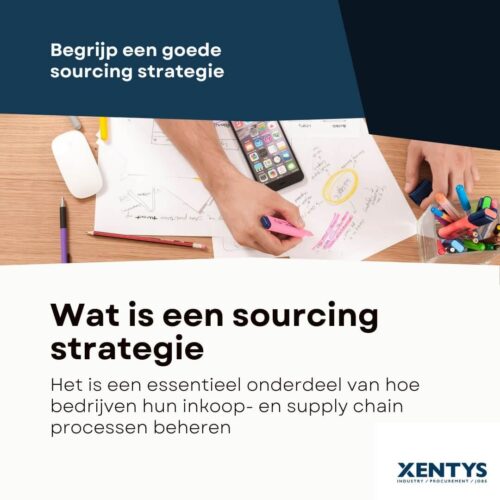Sourcing Strategy
A sourcing strategy is an essential part of how companies manage their procurement and supply chain processes. It acts as a kind of road map that determines where and how companies obtain their needed goods and services to achieve their business goals. This takes into account factors such as cost savings, risk management, quality assurance and supply chain sustainability.
What is a Sourcing Strategy?
Creating an effective sourcing strategy requires in-depth knowledge of the market, the specific needs of the organization and the capabilities of potential suppliers. It’s not just about finding the lowest price, but ensuring the best value for the entire company. This means that choices often have to be made between cost and quality of service, or between the efficiency of a single supplier and the flexibility of multiple suppliers.
A good sourcing strategy looks beyond the short-term. It takes into account future market trends, technological changes and changing business needs. It also includes demand management, which matches demand within the organization with market supply, and visual management, which uses data insights to make better purchasing decisions.
In short, a good sourcing strategy helps an organization strike the right balance between quality, cost, risk and innovation, providing a solid foundation for success.
Deep Understanding of Sourcing Strategies
The Building Blocks of a Successful Sourcing Strategy
An effective sourcing strategy is more than just a way to cut costs. It is a multi-faceted approach that lays the foundation for long-term success and competitive advantage. Determining the right strategy requires a thorough analysis of both internal needs and external market dynamics. The following elements are crucial:
- Market analysis and supplier evaluation: Understanding the market and potential suppliers is essential. This includes assessing supplier performance, capabilities, financial stability and their ability to meet the specific requirements of the organization.
- Risk management: Identifying and managing risks, such as supply interruptions, quality issues and market volatility, is a fundamental aspect. This includes diversifying suppliers, creating contingency plans and constantly monitoring risk factors.
- Cost and Value Analysis: In addition to the purchase price, it also involves the total cost of ownership (TCO) and the value that each vendor adds. This can include aspects such as innovation, technical support, training and flexibility.
- Sustainability and Ethics: Modern sourcing strategies also consider environmental, social and governance (ESG) factors. This means assessing suppliers on their sustainability practices and ethical standards, which is increasingly important to customers, regulators and investors.
- Strategic Partnerships: Developing long-term relationships with key suppliers can lead to enhanced innovation, exclusive benefits and shared growth opportunities. This requires a shift from a transactional approach to a more collaborative one.

FREE WHITE PAPER
How to Make a Category Plan
Implementation of Sourcing Strategies
Implementing a sourcing strategy is a dynamic process that requires constant adaptation and optimization. It includes:
- Project Management and Governance: Designating a responsible project manager, such as Patrick Rikken within an organization, provides leadership and coordination of sourcing initiatives. Governance structures ensure compliance and alignment with corporate strategy.
- Technology and Systems: The use of advanced technologies, such as ERP systems and AI-driven analytics tools, facilitates efficient sourcing processes, data-driven decision-making and improved transparency throughout the supply chain.
- Change Management: Successfully implementing a new sourcing strategy often requires changes in organizational culture, processes and practices. An effective change management plan is essential to overcome resistance and ensure the involvement of all stakeholders.
- Performance Measurement and Optimization: Establishing clear KPIs and regularly assessing performance against them is essential for measuring success and identifying areas for improvement.
The Role of Sourcing Specialists
Sourcing specialists play a key role in shaping and executing strategy. Their expertise in market analysis, negotiations, contract management and supplier relationship management is indispensable. They act as bridge-builders between internal stakeholders and external suppliers, which is crucial to successfully managing the supply chain.

FREE WHITE PAPER
Reduce Total Cost of Ownership (TCO) with the Kraljic Matrix
Conclusion
A well thought out and implemented sourcing strategy is indispensable for modern companies. It helps organizations not only manage costs and minimize risk, but also drive innovation, promote sustainability and build a strong, flexible supply chain that can respond to rapidly changing market dynamics.
Frequently Asked Questions about Sourcing Strategy
What is the difference between direct and indirect sourcing?
Direct sourcing refers to the purchase of materials, parts and products that directly contribute to the final product or service provided by a company. These items are critical to an organization’s core operations and production processes. Indirect sourcing, on the other hand, involves the purchase of goods and services that are necessary for day-to-day operations but are not directly incorporated into the final product. This can range from office supplies and facility services to professional services such as IT and human resources.
How does a sourcing strategy affect a company's bottom line?
A well-implemented sourcing strategy can significantly reduce costs through more efficient procurement processes, better negotiation outcomes with suppliers, and reducing risks that can lead to business interruption. In addition, improving the quality and reliability of purchased goods and services can lead to higher customer satisfaction and loyalty, indirectly contributing to revenue growth.
What are some best practices for developing a sourcing strategy?
- Stakeholder engagement: Ensure that all relevant internal stakeholders are involved in developing the strategy to incorporate their needs and insights.
- Market research: Conduct a comprehensive analysis of the market and potential suppliers to identify the best options.
- Risk Assessment: Proactively identify and manage risks associated with sourcing activities.
- Sustainability and ethics: Integrate sustainability and ethical considerations into the supplier selection process.
- Flexibility and scalability: Develop a strategy that can move with market and organizational changes.
- Performance measurement: Set clear KPIs and regularly measure supplier performance and strategy effectiveness.
How does technology fit into modern sourcing strategies?
Technology plays a crucial role in modernizing and optimizing sourcing processes. Electronic data interchange (EDI) systems, enterprise resource planning (ERP), and supply chain management software provide platforms for more efficient communication, data analysis, and process automation. In addition, advanced analytical tools and artificial intelligence enable organizations to process complex data and gain insights that improve decision-making.
How do you handle supplier management within a sourcing strategy?
Effective supplier management is essential to realizing the benefits of a sourcing strategy. This includes selecting suppliers based on both price and quality, building strong, mutually beneficial relationships, and continuously monitoring and assessing supplier performance. Regular communication, collaboration on improvement projects, and joint pursuit of innovation are all important aspects of successful supplier management.
Can a company employ multiple sourcing strategies simultaneously?
Yes, many companies employ a portfolio of sourcing strategies to meet the diverse needs of their various products and services. This can range from strategic partnerships for core products to spot purchases for non-critical goods. Using a mix of strategies allows companies to remain flexible and take full advantage of market opportunities while managing risk.
How does an open application work at xentys?
Submitting an open application will keep you informed of our current job openings and allow us to band you when we have a suitable position for you.
How to get started?
1.
First, make sure your resume succinctly reflects all your relevant skills, qualifications and experience.
2.
Then submit the open application to us using the form to the right. You may then receive a call from one of our recruitment specialists.
3.
Above all, remain patient, because finding the appropriate job opening may take some time.
4.
At xentys, we want to inform you about the job opening that suits you.
What an open application at xentys can bring you
Would you like to receive customized procurement job openings or would you prefer to see a general overview of all job openings? At xentys, we provide an individualized approach. We organize an interview with one of our specialists to get a good picture of your abilities, qualifications and preferences before we introduce you to an employer or client.


